This paper is designed as a resource tool for individuals, teams in ministry, or entire organizations – helping us reflect on our strategic approaches to ministry. It will be particularly relevant to media and communications related strategies
A key question for any ministry should always be, “Where does what we’re doing fit in?” Or, “Looking at the big picture, what strategic part are we playing, or, what specific contribution are we making?” These questions, in turn, may lead to asking, “Do we need to talking and possibly working with others to effectively realize this vision?”
Specifically the paper looks at the challenge of effective evangelism and church planting through seven different perspectives. Of course, the tools can also be helpful in looking at a wide range of other types of ministry. These observations have bee developed out of years of field experience, research, and Biblical reflection specifically because of the need to get as many of God’s people working together more effectively, each in their area of strength. At best this is just an introduction to these strategic issues. Each key point, in its own right, deserve considerable thought and prayer as decisions are being made about allocation of time, people, money, and other resources. In each case there is a brief:
- Summary of the idea
- A Biblical rationale or framework provided
- Some questions suggested regarding strategic implications.
1. Evangelism/Church Planting: Process or Event?
‘Events’ are frequently points that prompt, accelerate or provide memory markers in spiritual decision-making. Yet, individuals actually come into the Kingdom through a process. In turn, as these individuals mature in their faith they become building blocks of local fellowships.
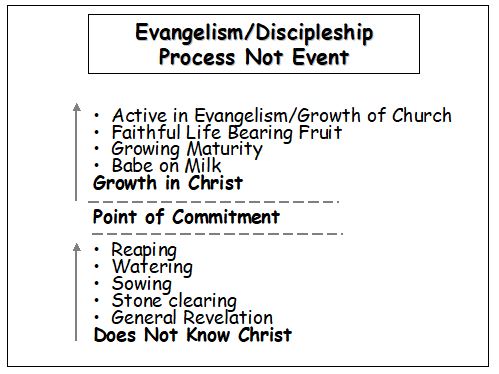
Biblical Rationale:
The ‘process’ of individuals by which individuals come into relationship with God in Christ is both explicit and implicit from Genesis to Revelation. Three NT passages highlight both Jesus and the Apostle Paul’s emphasis on the importance of understanding this process.
Matthew 13:1-23
Jesus introduces the agricultural metaphor of the sower, the seed, soil, and the related outcomes.
John 4:34—38
Using the same agricultural metaphor,
- Jesus ‘unpacks’ the process
- identifies the fact there are different players at different points in the process
- that each person’s role is valuable/important
- and that all those who have played a part will share equally in the joys/rewards at the outcomes.
I Corinthians 3:4-7
In the well-known Apollos/Paul discussion, the Apostle Paul takes Jesus’ John 4 explanation of the process of evangelism even further: he reaffirms that different roles in evangelism are typical; each role is valuable; and that, ultimately, it is the work of God’s spirit that brings people into the Kingdom. But possibly most startling, he explicitly states that God places no higher value on those who “reap” the harvest than He does on those who “sow.”
Strategic Considerations
Among the questions these points raise are:
- To what extent do our evangelism/church planting strategies recognize the various stages in the process?
- To what extent do we honor those who play different roles in this process?
- To what extent do we seek to not only be aware of the various ‘players’ but to develop approaches in our strategies that will actively link these people?
2. Different People, Different Spiritual States, Different Strategies
People in any general ‘audience’ (people group, etc.) at any moment in time are at different stages in their spiritual journey. Because of this, our strategy, tactics, and message content – explicit and implicit — and the spiritual status of the individual must be aligned as much as humanly possible. A close relationship with an individual might allow one to assess the person’s spiritual state (using the categories show on the right side of the diagram below). The more we refer to general groups of people (vs. individuals), the less able we are to assess their spiritual state. (Affinity groups, like the Pharisees/Sadducees, are exceptions where the group may decide collectively on their position and then seek to enforce its implications. Even then, there are exceptions based on factors we explore later; See Nicodemus [John 4, 7, and 19] and the ‘secret’ believers [John 12:42-43]). For further reflections on what factors influence a person’s readiness to consider Christ, see Section 3 below.
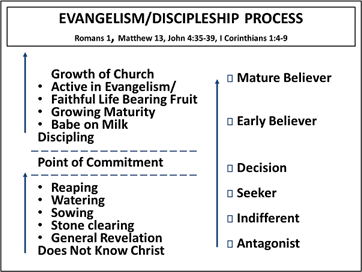
Biblical Rationale
The drama played out in the lead up to Jesus’ birth and the three, intensive years of His public ministry provide countless illustrations of individuals in the categories suggested in the diagram above. Examples:
John 11:45-48
The antagonists. The religious power structure (with a few notable exceptions) was explicitly antagonistic to Jesus seeing Him as a threat to their power, status, and the social order which conferred that special status.
Matthew 23:37
The indifferent. Jesus bemoans the fact that Jewish society, culturally religious and ostensibly God aware, was so wrapped up in their daily affairs and misguided assumptions that they were indifferent to His presence.
Mark 1:40-45
The seekers. Of the 22-23 people Jesus meets one to one in the four gospels, all came to Him highly motivated by questions or issues they knew could not resolve. It is interesting to note that over 85% came with physical and emotional issues, not ones that in the West we would call ‘spiritual.’ The exceptions were Nicodemus (John 3:1-21, the ‘rich young ruler (Luke 18:18-30), and the lawyer of Luke 10:25-37.
John 6:35-68
The believers. When the time for decision comes, who turns away and who follows.
Strategic Considerations
- Do our strategies/tactics recognize these stages of the spiritual journey?
- What particular challenges or spiritual roadblocks are present that may keep them from moving to greater levels of openness and, eventually, belief?
- How might awareness of categories like these affect our strategic and tactical approach to evangelism/church planting?
- Might there be certain types of individuals, forms of witness, or media that would be more appropriate than another for some of these categories? (See Section 5 below for further considerations on this aspect of the evangelism/church planting [e/cp] challenge.)
3. Components of Decision for Spiritual Change
It is clear that God draws all men and women to Himself and that, in the end, it is only the work of the Holy Spirit that ushers individuals into The Kingdom (Titus 3:5-6, 2 Peter 3:9, etc.). Yet, a more careful reading of Scripture makes clear that there are qualities that are consistent with openness to the Good News and/or a readiness to accept the message of Jesus. Knowing some of these factors can be very helpful as we assess audiences (people groups, etc.), plan strategies, seek to establish goals for our work, or monitor its effectiveness.
The Biblical rationale for this diagram is given below. However, in broad strokes we see throughout Scripture there are primarily three factors that fuel and openness and/or desire for change. They are knowledge, motivation, (which leads to) attitude or openness (toward the proposed change). It is only as there is sufficient motivation informed by sufficient knowledge that a person’s attitude is receptive to change.
Consider the diagonal line in the diagram going from the lower left to the upper right. Where knowledge is low and/or bad (as in ill-informed individuals) and combines with low motivation, an individual’s resistance, active or passive, will be the result (antagonist at worst, indifferent at best). For this group, clearly the only categories of ministry can be stone clearing, sowing, and watering.
Where sufficient knowledge combines with adequate motivation consideration of change leading to commitment of new beliefs and/or action is possible. It is in this sector that evangelism/church planting strategies can do ‘reaping’ leading to discipling and, eventually, leadership development. And, it is vital that we always keep in mind the work of the Holy Spirit in an individual’s life. That’s why prayer is the bedrock element in any strategic plan. We pray that God’s Holy Spirit will speak to their hearts when no “strategy” can.
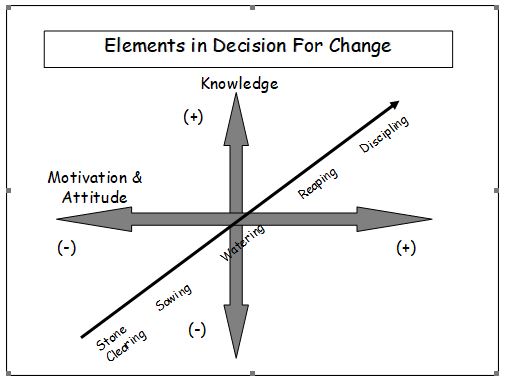
Biblical Rationale
Illustrations from two ends of the knowledge/motivation/attitude spectrum serve to make the point.
John 9:13-34
The ruling religious leaders were high in knowledge but de-motivated to consider a new message which threatened their status. (See also John 7:25-52, John 19:1-16.)
Mark 1:40-45, Luke 23:39-43
The ragged, broken, socially ostracized leper and one of the criminals on the cross would appear to have minimal knowledge (compared, say, to the Pharisees/Sadducees) but sufficient knowledge combined with high motivation to create an openness to Jesus’ transforming power.
John 3:1-21, 7:50-53, 19:38-42 and Luke 8:40-56
Nicodemus and Jairus are classic illustrations of well-defined attitudes change based on changing knowledge and/or circumstances which affect motivation.
- Nicodemus’ three appearances in John’s gospel clearly chronicle his journey from motivated doubt, through tentative peer advocacy, to open declaration of his commitment.
- Jairus, a synagogue leader in Jesus’ adopted home town was clearly a part of the Jewish religious establishment. However, with a dying daughter and all likely remedies exhausted, his ‘costs/benefits analysis’ leads him to appeal to Jesus for help.
Strategic Consideations
- What might be some of the implications of the diagram and scriptural references/stories for our e/cp strategies?
- Have we done an analysis of our audience using the thinking suggested in this diagram and implied by the Scriptures?
- If our e/cp strategies consciously took these issues into account, how might it affect the specifics of our approach to use of people and/or media?
- Have we sought to develop specific approaches, content, strategies, and tactics that align with where they are on the spiritual journey?
4. The Process of Decision-Making For Change
Biblical content and sociological research (truth is always God’s truth) make clear that decision-making for change is always a process. This, of course, relates to Section 1, Evangelism: A Process Or Event? The key elements are:
- Sufficient knowledge
- Reflection on or consideration of the knowledge (information)
- Reinforcement/expansion of the knowledge
Note: Classically these first three steps are an on-going loop which moves on to the next stage only when there is sufficient motivation. In consideration/acceptance of Jesus, this loop may appear to be comparatively short, as in the case of children. Or, lengthy, as in the case of those who make a decision for Christ later in life.
- Sufficient motivation for change
- Conviction – belief that the change will produce a desired outcome that outweighs any potential negatives.
- Decision – commitment of the conviction that motivates the critical next step.
- Action – Turning thought and conviction into reality.
- Recommitment – Reaffirmation of previous decision.
Consider the relationship of the diagram below and that found in Section 3. This suggests that for spiritual movement of an individual upward along the diagonal line in diagram 3, from antagonism or indifference to belief, the process shown in the diagram below must occur.

Biblical Rationale
Consider two of the cases previously mentioned; Nicodemus and Jairus.
John 3:1-21, 7:50-53, 19:38-42
Nicodemus appears in John 3 bringing parallel sets of information: the traditional information rooted in his Jewish religious leader’s training; and, the new information rising out of his own observation of Jesus life & ministry and, likely, the rising level of discussion about Jesus both among both his peers and the general public with whom he mixed. We see the distinct passage of Nicodemus’ process along this continuum of conviction and commitment as he: first, comes to Jesus by night – afraid of his peers; then, advocating on Jesus behalf with his peers and suffering their ridicule; finally, his public affirmation as he goes public — joining Joseph of Arimathea to take Jesus body from the cross and place it in the tomb.
Luke 8:40-56
Jairus has a 12 year old daughter who is dying. Desperate he falls to his knees in front of Jesus and begs for help. In character, Jesus responds and the girls is healed – in fact, brought back from the dead! The context is as follows. Jairus was a religious leader in Jesus’ adopted home town of Capernaum. His connections with the religious establishment in Jerusalem would have been evident. As a leader of the synagogue where Jesus’ regularly taught (Mark 1), Jairus had an up-close view of the spectacular trajectory of Jesus’ ministry. Jairus also knew Jesus’ disciples since we know this was Peter’s home town. His call on Jesus was only well into Jesus’ ministry – possibly even in the final few months. Based on the state of the girl’s condition when Jairus sought out Jesus, he had tried every other possible option before, in desperation, turning to Jesus, at 11:59, as the court of last resort. Jairus represents a classic case history in which, in a comparatively short period of time, we can clearly see the progression of the elements outlined in the diagram above. He had a rich data base of traditional Jewish religious assumptions. He had an in-depth exposure to Jesus’ ministry. Despite the compelling evidence which Jairus regularly saw, the personal ‘risk/reward’ balance was insufficient to motivate turning his back on his religious peers and threaten his social standing. Only when his perceived need became sufficiently acute was he prepared to, in front of his own ‘parishioners,’ in total humility (remember, this is an eastern culture) fall begging to the ground in front of Jesus in the middle of the town, in broad daylight. The potential of personal rewards overwhelmed the potential personal/professional risks.
Strategic Considerations
The audiences of Palestine in Jesus’ day and the world of today provide interesting basis for comparison.
- How do we plan effective e/cp strategies when we know that, at any given moment, members of the wider ‘audience’ are at different stages in the decision-making process?
- Personal 1:1 relationships may or may not give authentic insight regarding the state of an individual’s heart or spiritual journey. However, what of the thousands or millions who are not in an authentic personal relationship with a Christian evangelist? For instance, those exposed daily to witness via radio, TV, internet, social media other forms of communication. Consider the power of God’s general revelation, dreams, visions, and/or other forms of God’s loving communication? Genuinely committed to the most effective e/cp strategies, how do we take into account and/or seek to link these forms of witness with personal, 1:1 witness for greatest effectiveness? (Remember, Jairus input about Jesus was from far more than personal observation. From both Jesus’ friends and enemies, in Capernaum’s cafes, markets, in the homes of friends, and on the occasional trip up to Jerusalem, Jairus received a constant stream of varied input from other sources.)
5. Adoption of Innovation: Change in Belief and Practice
Another way to look at these issues is by examining how groups respond to messages about or opportunities to change. Based on the ground-breaking research and analysis done by Everett Rogers (see his Diffusion of Innovations, 5th Ed, 2003. Also Malcolm Gladwell, The Tipping Point, 2000 and Geoffrey Moore’s, Crossing The Chasm, 1999, Rodney Stark, The Cities of God, 2005, and the Book of Acts) the diagram below illustrates the typical stages in any individual or people group regarding adoption of a new belief and/or practice. The stages of levels of commitment to a belief or practice are typically the same; Quechua women in the Andes considering the innovation of oral rehydration therapy for their infant children in the face of traditional medicine and the power of local witchdoctors. Or, an individual considering Christ in the face of tradition, family, and the wider social/economic pressure. While the change under consideration and the channels of communication/influence at any given time may be radically different, the stages of the journey, however, are predictably the same.
This diagram is a further perspective on the audience as has been unpacked in the first four diagrams. It is simply another way to understand what is going on with the individual or group that is the focus of our evangelism/church planting effort.
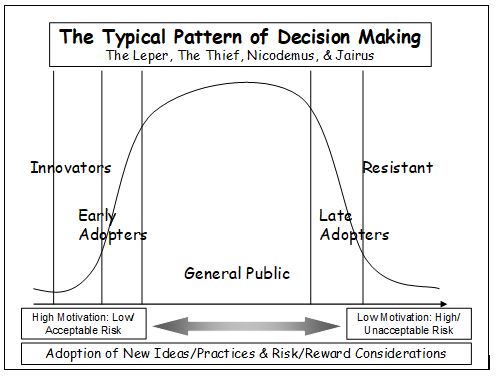
Biblical Rationale
Case histories for people in all of these categories have already been cited as is suggested in the header of the diagram. At the two left/right extremes consider:
Innovators/Early Aopters
- Leper – Mark Chapter 1
- Thief on the cross – Luke 23
- Of the 22-23 people who came to Jesus the 88% of those individuals who came with the ‘ordinary’ brokenness of their lives.
The Late Adopters/Resistant
- Jairus – Juke 8
- Nicodemus – John 3, 7, and 19
- The Pharisees and Sadducees – John 9
Strategic Considerations
- Reflecting on this diagram as a diagnostic/advisory tool, what implications might there be for our specific evangelism and/or church development strategies?
- Which of these audiences do we feel we are addressing with the primary strategy(ies) we are employing?
- Since this analytical tool is about those crossing the line from unbelief/lack of commitment to belief/commitment, how do we manage to capture the attention and hearts of the innovative/early adopters while maintaining an effective, engaging communication/witness with the remainder of the as of yet, undecided?
- Are all forms of communications and types of content going to be equally relevant to all of these categories in our audience. If not, how do we develop and/or engage with other individuals or ministries who have relevant/effective strategies that may compliment our efforts.
6. Different Media Play Different Roles & All Can Be Important
The issues raised by Strategic Implications in #4 and the issues demonstrated in diagram #5 show that, even in Jesus day, many forms of witness and influence were at work. While many traditional factors of influence remain the same, today’s audience’s thinking and decision-making is influenced by a world of media, information, and experience far more complex than first century Palestine’s inhabitants.
A wide range of empirical research (particularly in the fields of communication for social change and innovation) make clear that different forms of communication have different strengths and play more or less effective roles at various stages in the decision-making, commitment to change process. This diagram provides the general profile of what is now widely held regarding the power/relevance/influence of various forms of communication.
In social settings where adoption of a new belief and/or practice carries with it higher potential risk or negative implications, the importance of personal relationships affirming the new belief or practice is even more critical – particularly as an individual approaches the ‘decision-making’ stage. The implications for a ministry is fairly obvious (see John 12:42).
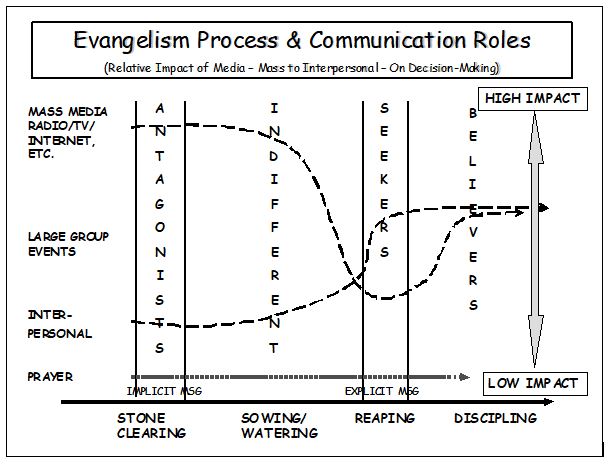
Biblical Rationale
Consider once again the New Testament –
- Metaphor of the sower (Matthew 13, John 4, and I Corinthians 3). Though working in a joint ultimate purpose, clearly the role and activities expected of the sower and the reaper can be very different.
- Reflect on the cases of the 22-23 who came to Jesus personally and/or those nameless individuals found in John 10:42 who came to belief. It is not a very great stretch to imagine that they had had previous exposure to the message/person; likely as participants in hillside preaching audiences, as observers of encounters by Jesus with friends or neighbors, receivers of input from family, friends, and the stories that ‘circulated in the streets’.
- The particular case of those in John 10:42 is interesting because the context passage states explicitly that this was a region where John (the Baptist) had previously done his baptizing. So, at a minimum, this audience had been exposed to John (sower/waterer?) and the ‘buzz’ which surrounded his message. And, they might have even been part of the crowd when Jesus was baptized by John and there was that very special incursion of the Holy Spirit!
Strategic Considerations
- Do we see the various media as equally valuable, therefore, equally important for us to engage in any strategic plans? (participants in any strategic or tactical initiatives being undertaken, etc.)
- If we do not see these other media/communication channels as “different in nature but equal in value” what are the implications? (See I Cor 3 where the whole controversy was rooted in man’s effort to ascribe value to personalities and/or different roles in spiritual ministry.)
- What specific/intentional steps might be called for to identify, open communications with, and possibly explore joint strategic thinking with other ministries focused on different forms of evangelism/church pplanting-motivated communications with the same audience we are trying to reach?
- What value might there be in coordinating these various channels of influence with their strengths and differing roles/capacities?
- What knowledge, skills, and/or commitment to a collaborative process (partnership, alliance, network, etc.) will be required to see maximum benefit realized?
- If such communication and/or strategic linkage is desirable and actually occurs, what might be some of the possible benefits – value added to our collective e/cp efforts?
7. Diversity of Media/Rate of Innovation
It would appear that both the diversity of media (channels/forms of communication) employed and the rate of innovation in type, methodology, and content within these media is significantly greater at the ‘left end’ of the evangelism continuum than at the right. See shading in diagram below illustrating this idea. (This is not in any way to be confused with actual ratios of diversity/innovation on which I know of no explicit research. I suspect, however, that the actual ratios of difference are likely to be far greater than even the shading below suggest!)
It is quite natural to ask, “Is this portrayal of the situation really true and, if so, why?” Here are a few suggestions as to the why.
Ministry at the ‘left end’ of the continuum –
- Is much more heavily technology based in its strategies and tactics. This has a powerful natural influence on both diversity of media and innovation rates. Consider the inherent rate of development and change in the technology fields associated with these types of communication.
- Deals with an audience whose expectations are already geared to and adoption of innovation (consider the radical change of resistant audiences in method of response to traditional broadcast – radio/tv – channels as they have transitioned from the traditional letters, phone calls, faxes, etc. as their response channels of choice to today in the greater ME where it is estimated over 80% of all response is via SMS!. In these audiences, expectations are changing with increasing rapidity regarding channels used, formats expected, demands for creativity, freshness/change in content, etc., etc. Smartphones, “social media,” and the wide range of communications/messaging apps have changed the world of strategies forever!
- The very choice of channels/forms of communication at the ‘left end’ of the continuum demands choice within extreme diversity (choosing channels, style, content, etc., etc.). This dynamic atmosphere naturally calls for (in the commercial world, forces) constant review of the appropriateness of choices made within this often bewildering array of communication options. A key part of this is specific expectation re feedback, audience research, outcomes, metrics, on-going means for assessment, and frequency of evaluation re effectiveness.
Even an informal study of Scripture points to the fact that there have to be different messages for different audiences. (See “more implicit” and “more explicit” boxes in diagram below.)
- In the New Testament we see Jesus communicating in at least four ways:
- Declaration: Mass communication: Preaching on the hillsides, from the boat, etc.
- Discussion: Group interaction: The countless cases of jesus engaging in discussion/argument with Jewish leaders, etc. (often with disciples and the general public as active observers).
- Dialogue: One on One Conversations: The previously noted 22-23 individuals with whom Jesus has personal conversations about issues on their hearts.
- Demonstration: Miracles The miracles which he repeatedly (see John 5—12) held were the proof of credibility of his words (contrasting words and works).
- It is fascinating that in His encounters with the 22-23 who came with physical and emotional/psychological issues, He never raises no spiritual questions (at least in terms that today, in the West, we would define “spiritual”). This seems to be consistent with what is found in almost all research about change and adoption of new beliefs and practice – particularly where there are significant social implications attached to the change/adoption. At the left end the message is more explicit about the individual/social need and less explicit about the underlying assumptions (spiritual basis) of the problem(s).
- Jesus Himself is explicit in this distinction – see Luke 8:9-10 – and note that He places this distinction in the context of the parable of the sower – the metaphor which we have consistently used through these points of analysis!
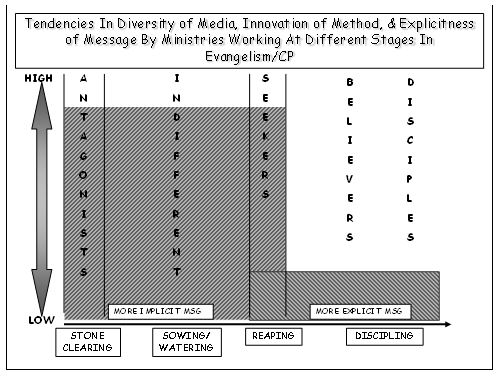
Biblical Rationale
See above.
Strategic Considerations
- Does this suggest that ministries working at the different ends of the spiritual journey continuum are naturally divided by the issues raised above?
- Is it possible that the rates of innovation between ministries at these two ends of the spiritual journey continuum is taking ministries at the two ends farther and farther apart? In other words, is the diversity/innovation gap widening? If so, what are the implications?
- What value might there be in giving consideration to an integrated approach which pro-actively links ministries all along the continuum – harvesting and sharing the benefits of varied forms of ministry, rates/types of innovation, learning being realized, seeing greater numbers come into the Kingdom and growing into healthy, locally led, reproducing fellowships because each ministry has been able to joyfully and productively do what it does best while consciously holding hands with fellow believers committed to the same outcomes but with quite diverse gifts/callings (see Romans, 12, I Corinthians 12, Ephesians 4, etc.).
